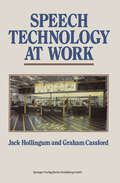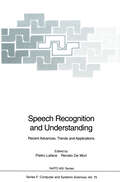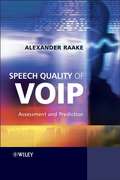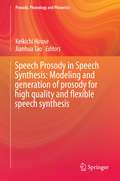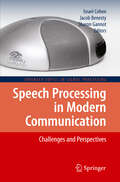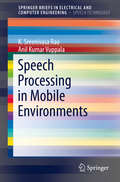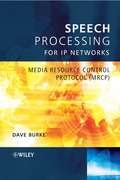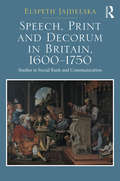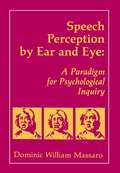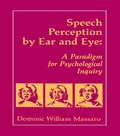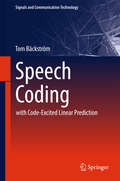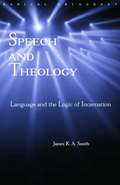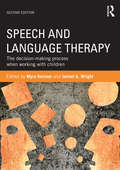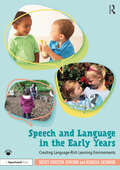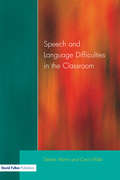- Table View
- List View
Speech Technology at Work
by Jack Hollingum Graham CassfordSpeech technology - the use of speech as a means of sending information to, and receiving information from computer systems has been in use as a research tool for many years. Only recently has it begun to move out of the laboratory and into commercially worthwhile applications, first with compressed and synthesised spoken messages, then with computer recognition of spoken messages, and today with diverse applications involving both recognition and reproduction of human speech. We have written this book because we believe the technology has now advanced to the point where many more applications of voice recognition and response are both feasible and economically attractive. Computers that can understand everyday speech are still a distant prospect, but provided the limitations of present day equipment are clearly understood there is much that can be achieved with it. Our aim is to show, in non-technical language, what is now possible with the help of speech technology. The text includes many examples of current applications in industry, commerce and other fields, and we have selected five current industrial applications combining speech recognition and response for more detailed attention. Industrial cases have been chosen both because we see industry as an important growth area for speech applications in the next few years, and because it presents some of the greatest difficulties in speech recognition - if you can make it work in industry, then you can make it work almost anywhere.
Speech Recognition and Understanding: Recent Advances, Trends and Applications (NATO ASI Subseries F: #75)
by Pietro Laface Renato DeMoriThe book collects the contributions to the NATO Advanced Study Institute on "Speech Recognition and Understanding: Recent Advances, Trends and Applications", held in Cetraro, Italy, during the first two weeks of July 1990. This Institute focused on three topics that are considered of particular interest and rich of i'p.novation by researchers in the fields of speech recognition and understanding: Advances in Hidden Markov modeling, connectionist approaches to speech and language modeling, and linguistic processing including language and dialogue modeling. The purpose of any ASI is that of encouraging scientific communications between researchers of NATO countries through advanced tutorials and presentations: excellent tutorials were offered by invited speakers that present in this book 15 papers which sum marize or detail the topics covered in their lectures. The lectures were complemented by discussions, panel sections and by the presentation of related works carried on by some of the attending researchers: these presentations have been collected in 42 short contributions to the Proceedings. This volume, that the reader can find useful for an overview, although incomplete, of the state of the art in speech understanding, is divided into 6 Parts.
Speech Quality of VoIP: Assessment and Prediction
by Alexander RaakeFinally a comprehensive overview of speech quality in VoIP from the user's perspective! Speech Quality of VoIP is an essential guide to assessing the speech quality of VoIP networks, whilst addressing the implications for the design of VoIP networks and systems. This book bridges the gap between the technical network-world and the psychoacoustic world of quality perception. Alexander Raake’s unique perspective combines awareness of the technical characteristics of VoIP networks and original research concerning the perception of speech transmitted across them. Starting from the network designer’s point of view, the different characteristics of the network are addressed, and then linked to features perceived by users. This book provides an overview of the available knowledge on the principal, relevant aspects of speech and speech quality perception, of speech quality assessment, and of transmission properties of telephone and VoIP networks, and of the related perceptual features and resulting speech quality. Discussing new research into the specific time-varying degradations VoIP brings along, but also the considerable potential of quality improvement to be achieved with wideband speech transmission, Alexander Raake demonstrates how network and service characteristics impact on the users perception of quality. Speech Quality of VoIP: Offers an insight into speech quality of VoIP from a user's perspective. Presents an overview of different modelling approaches and a parametric network-planning model for quality prediction in VoIP networks. Draws on innovative new research on the quality degradation characteristic of VoIP. Explains in detail how telephone speech quality can be greatly enhanced with VoIP’s wideband speech transmission capability. Assesses the vast collection of references into the technical and scientific literature related to VoIP quality. Illustrates concepts throughout with mathematical models, algorithms and simulations. Speech Quality of VoIP is the definitive guide for researchers, engineers and network planners working in the field of VoIP, Quality of Service, and speech communication processing in telecommunications. Advanced undergraduate and graduate students on telecommunication and networking courses will also find this text an invaluable resource.
Speech Prosody in Speech Synthesis: Modeling And Generation Of Prosody For High Quality And Flexible Speech Synthesis (Prosody, Phonology and Phonetics)
by Keikichi Hirose Jianhua TaoThe volume addresses issues concerning prosody generation in speech synthesis, including prosody modeling, how we can convey para- and non-linguistic information in speech synthesis, and prosody control in speech synthesis (including prosody conversions). A high level of quality has already been achieved in speech synthesis by using selection-based methods with segments of human speech. Although the method enables synthetic speech with various voice qualities and speaking styles, it requires large speech corpora with targeted quality and style.Accordingly, speech conversion techniques are now of growing interest among researchers. HMM/GMM-based methods are widely used, but entail several major problems when viewed from the prosody perspective; prosodic features cover a wider time span than segmental features and their frame-by-frame processing is not always appropriate. The book offers a good overview of state-of-the-art studies on prosody in speech synthesis.
Speech Processing in Modern Communication: Challenges and Perspectives (Springer Topics in Signal Processing #3)
by Israel Cohen Jacob Benesty Sharon GannotModern communication devices, such as mobile phones, teleconferencing systems, VoIP, etc., are often used in noisy and reverberant environments. Therefore, signals picked up by the microphones from telecommunication devices contain not only the desired near-end speech signal, but also interferences such as the background noise, far-end echoes produced by the loudspeaker, and reverberations of the desired source. These interferences degrade the fidelity and intelligibility of the near-end speech in human-to-human telecommunications and decrease the performance of human-to-machine interfaces (i.e., automatic speech recognition systems). The proposed book deals with the fundamental challenges of speech processing in modern communication, including speech enhancement, interference suppression, acoustic echo cancellation, relative transfer function identification, source localization, dereverberation, and beamforming in reverberant environments. Enhancement of speech signals is necessary whenever the source signal is corrupted by noise. In highly non-stationary noise environments, noise transients, and interferences may be extremely annoying. Acoustic echo cancellation is used to eliminate the acoustic coupling between the loudspeaker and the microphone of a communication device. Identification of the relative transfer function between sensors in response to a desired speech signal enables to derive a reference noise signal for suppressing directional or coherent noise sources. Source localization, dereverberation, and beamforming in reverberant environments further enable to increase the intelligibility of the near-end speech signal.
Speech Processing in Mobile Environments (SpringerBriefs in Speech Technology)
by K. Sreenivasa Rao Anil Kumar VuppalaThis book focuses on speech processing in the presence of low-bit rate coding and varying background environments. The methods presented in the book exploit the speech events which are robust in noisy environments. Accurate estimation of these crucial events will be useful for carrying out various speech tasks such as speech recognition, speaker recognition and speech rate modification in mobile environments. The authors provide insights into designing and developing robust methods to process the speech in mobile environments. Covering temporal and spectral enhancement methods to minimize the effect of noise and examining methods and models on speech and speaker recognition applications in mobile environments.
Speech Processing for IP Networks: Media Resource Control Protocol (MRCP)
by David BurkeMedia Resource Control Protocol (MRCP) is a new IETF protocol, providing a key enabling technology that eases the integration of speech technologies into network equipment and accelerates their adoption resulting in exciting and compelling interactive services to be delivered over the telephone. MRCP leverages IP telephony and Web technologies such as SIP, HTTP, and XML (Extensible Markup Language) to deliver an open standard, vendor-independent, and versatile interface to speech engines. Speech Processing for IP Networks brings these technologies together into a single volume, giving the reader a solid technical understanding of the principles of MRCP, how it leverages other protocols and specifications for its operation, and how it is applied in modern IP-based telecommunication networks. Focusing on the MRCPv2 standard developed by the IETF SpeechSC Working Group, this book will also provide an overview of its precursor, MRCPv1. Speech Processing for IP Networks: Gives a complete background on the technologies required by MRCP to function, including SIP (Session Initiation Protocol), RTP (Real-time Transport Protocol), and HTTP (Hypertext Transfer Protocol). Covers relevant W3C data representation formats including Speech Synthesis Markup Language (SSML), Speech Recognition Grammar Specification (SRGS), Semantic Interpretation for Speech Recognition (SISR), and Pronunciation Lexicon Specification (PLS). Describes VoiceXML - the leading approach for programming cutting-edge speech applications and a key driver to the development of many of MRCP’s features. Explains advanced topics such as VoiceXML and MRCP interworking. This text will be an invaluable resource for technical managers, product managers, software developers, and technical marketing professionals working for network equipment manufacturers, speech engine vendors, and network operators. Advanced students on computer science and engineering courses will also find this to be a useful guide.
Speech, Print and Decorum in Britain, 1600--1750: Studies in Social Rank and Communication
by Elspeth JajdelskaFilling an important gap in the history of print and reading, Elspeth Jajdelska offers a new account of the changing relationship between speech, rank and writing from 1600 to 1750. Jajdelska draws on anthropological findings to shed light on the different ways that speech was understood to relate to writing across the period, bringing together status and speech, literary and verbal decorum, readership, the material text and performance. Jajdelska's ambitious array of sources includes letters, diaries, paratexts and genres from cookery books to philosophical discourses. She looks at authors ranging from John Donne to Jonathan Swift, alongside the writings of anonymous merchants, apothecaries and romance authors. Jajdelska argues that Renaissance readers were likely to approach written and printed documents less as utterances in their own right and more as representations of past speech or as scripts for future speech. In the latter part of the seventeenth century, however, some readers were treating books as proxies for the author's speech, rather than as representations of it. These adjustments in the way speech and print were understood had implications for changes in decorum as the inhibitions placed on lower-ranking authors in the Renaissance gave way to increasingly open social networks at the start of the eighteenth century. As a result, authors from the lower ranks could now publish on topics formerly reserved for the more privileged. While this apparently egalitarian development did not result in imagined communities that transcended class, readers of all ranks did encounter new models of reading and writing and were empowered to engage legitimately in the gentlemanly criticism that had once been the reserve of the cultural elites. Shortlisted for the European Society for the Study of English (ESSE) book prize 2018
Speech, Print and Decorum in Britain, 1600--1750: Studies in Social Rank and Communication
by Elspeth JajdelskaFilling an important gap in the history of print and reading, Elspeth Jajdelska offers a new account of the changing relationship between speech, rank and writing from 1600 to 1750. Jajdelska draws on anthropological findings to shed light on the different ways that speech was understood to relate to writing across the period, bringing together status and speech, literary and verbal decorum, readership, the material text and performance. Jajdelska's ambitious array of sources includes letters, diaries, paratexts and genres from cookery books to philosophical discourses. She looks at authors ranging from John Donne to Jonathan Swift, alongside the writings of anonymous merchants, apothecaries and romance authors. Jajdelska argues that Renaissance readers were likely to approach written and printed documents less as utterances in their own right and more as representations of past speech or as scripts for future speech. In the latter part of the seventeenth century, however, some readers were treating books as proxies for the author's speech, rather than as representations of it. These adjustments in the way speech and print were understood had implications for changes in decorum as the inhibitions placed on lower-ranking authors in the Renaissance gave way to increasingly open social networks at the start of the eighteenth century. As a result, authors from the lower ranks could now publish on topics formerly reserved for the more privileged. While this apparently egalitarian development did not result in imagined communities that transcended class, readers of all ranks did encounter new models of reading and writing and were empowered to engage legitimately in the gentlemanly criticism that had once been the reserve of the cultural elites. Shortlisted for the European Society for the Study of English (ESSE) book prize 2018
Speech Perception By Ear and Eye: A Paradigm for Psychological Inquiry
by Dominic W. MassaroFirst published in 1987. Routledge is an imprint of Taylor & Francis, an informa company.
Speech Perception By Ear and Eye: A Paradigm for Psychological Inquiry
by Dominic W. MassaroFirst published in 1987. Routledge is an imprint of Taylor & Francis, an informa company.
Speech Perception By Ear and Eye: A Paradigm for Psychological Inquiry
by Dominic W. Massaro Jeffry A. SimpsonFirst published in 1987. Routledge is an imprint of Taylor & Francis, an informa company.
Speech Perception By Ear and Eye: A Paradigm for Psychological Inquiry
by Dominic W. Massaro Jeffry A. SimpsonFirst published in 1987. Routledge is an imprint of Taylor & Francis, an informa company.
Speech Coding: with Code-Excited Linear Prediction (Signals and Communication Technology)
by Tom BäckströmThis book provides scientific understanding of the most central techniques used in speech coding both for advanced students as well as professionals with a background in speech audio and or digital signal processing. It provides a clear connection between the Why’s?, How’s?, and What’s, such that the necessity, purpose and solutions provided by tools should be always within sight, as well as their strengths and weaknesses in each respect. Equivalently, this book sheds light on the following perspectives for each technology presented: Objective: What do we want to achieve and especially why is this goal important? Resource / Information: What information is available and how can it be useful? Resource / Platform: What kind of platforms are we working with and what are the capabilities/restrictions of those platforms? This includes properties such as computational, memory, acoustic and transmission capacity of devices used. Solutions: Which solutions have been proposed and how can they be used to reach the stated goals? Strengths and weaknesses: In which ways do the solutions fulfill the objectives and where are they insufficient? Are resources used efficiently? This book concentrates solely on code excited linear prediction and its derivatives since mainstream speech codecs are based on linear prediction It also concentrates exclusively on time domain techniques because frequency domain tools are to a large extent common with audio codecs.
Speech Bubbles 2 User Guide: Supporting Speech Sound Development in Children (Speech Bubbles 2)
by Melissa PalmerThis book is the supporting guide for Speech Bubbles 2, an exciting series created for speech language therapists and pathologists, parents and caregivers, teachers and other professionals working with children who have delayed or disordered speech sound development. The guide contains detailed notes to support the effective use of all of the picture books in the series, targeting the following sounds: /v/, /z/, /sh/, /ch/, /h/, /y/, /j/, /r/, /l/, /w/, /r/ blends and /l/ blends. Speech Bubbles 2 is the second set in a series of picture books designed to be used by those working with children who have delayed or disordered speech sound development, children receiving speech therapy or those wanting to provide sound awareness activities for children. The set includes 12 beautifully illustrated storybooks, each targeting a different speech sound in different positions within words, and a user guide with notes on each individual story. Designed to be read aloud to the child in a therapy, classroom or home setting, the stories create a fun and engaging activity that can be returned to again and again. The full set includes: Twelve bright and engaging stories targeting the following early developing sounds and sounds frequently targeted in speech therapy: /v/, /z/, /sh/, /ch/, /h/, /y/, /j/, /r/, /l/, /w/, /r/ blends and /l/ blends. A user guide supporting the use of the stories, with individual notes on each. Perfect not just for therapy but also for encouraging early sound awareness and development, this is an engaging and invaluable resource for speech language therapists and pathologists, parents and caregivers and teachers working with children aged 2–8 years.
Speech Bubbles 2 User Guide: Supporting Speech Sound Development in Children (Speech Bubbles 2)
by Melissa PalmerThis book is the supporting guide for Speech Bubbles 2, an exciting series created for speech language therapists and pathologists, parents and caregivers, teachers and other professionals working with children who have delayed or disordered speech sound development. The guide contains detailed notes to support the effective use of all of the picture books in the series, targeting the following sounds: /v/, /z/, /sh/, /ch/, /h/, /y/, /j/, /r/, /l/, /w/, /r/ blends and /l/ blends. Speech Bubbles 2 is the second set in a series of picture books designed to be used by those working with children who have delayed or disordered speech sound development, children receiving speech therapy or those wanting to provide sound awareness activities for children. The set includes 12 beautifully illustrated storybooks, each targeting a different speech sound in different positions within words, and a user guide with notes on each individual story. Designed to be read aloud to the child in a therapy, classroom or home setting, the stories create a fun and engaging activity that can be returned to again and again. The full set includes: Twelve bright and engaging stories targeting the following early developing sounds and sounds frequently targeted in speech therapy: /v/, /z/, /sh/, /ch/, /h/, /y/, /j/, /r/, /l/, /w/, /r/ blends and /l/ blends. A user guide supporting the use of the stories, with individual notes on each. Perfect not just for therapy but also for encouraging early sound awareness and development, this is an engaging and invaluable resource for speech language therapists and pathologists, parents and caregivers and teachers working with children aged 2–8 years.
Speech Bubbles 2: Supporting Speech Sound Development in Children (Speech Bubbles 2)
by Melissa PalmerSpeech Bubbles 2 is the second set in a series of picture books designed to be used by those working with children who have delayed or disordered speech sound development, children receiving speech therapy or those wanting to provide sound awareness activities for children. The set includes 12 beautifully illustrated storybooks, each targeting a different speech sound in different positions within words, and a user guide with notes on each individual story. Designed to be read aloud to the child in a therapy, classroom or home setting, the stories create a fun and engaging activity that can be returned to again and again. The full set includes: Twelve bright and engaging stories targeting the following early developing sounds and sounds frequently targeted in speech therapy: /v/, /z/, /sh/, /ch/, /h/, /y/, /j/, /r/, /l/, /w/, /r/ blends and /l/ blends. A user guide supporting the use of the stories, with individual notes on each. Perfect not just for therapy but also for encouraging early sound awareness and development, this is an engaging and invaluable resource for speech and language therapists and pathologists, parents and caregivers and teachers working with children aged 2– 8 years.
Speech and Theology: Language and the Logic of Incarnation (Routledge Radical Orthodoxy)
by James K.A. SmithGod is infinite, but language finite; thus speech would seem to condemn Him to finitude. In speaking of God, would the theologian violate divine transcendence by reducing God to immanence, or choose, rather, to remain silent? At stake in this argument is a core problem of the conditions of divine revelation. How, in terms of language and the limitations of human understanding, can transcendence ever be made known? Does its very appearance not undermine its transcendence, its condition of unknowability?Speech and Theology posits that the paradigm for the encounter between the material and the divine, or the immanent and transcendent, is found in the Incarnation: God's voluntary self-immersion in the human world as an expression of His love for His creation. By this key act of grace, hinged upon Christs condescension to human finitude, philosophy acquires the means not simply to speak of perfection, which is to speak theologically, but to bridge the gap between word and thing in general sense.
Speech and Theology: Language and the Logic of Incarnation (Routledge Radical Orthodoxy)
by James K.A. SmithGod is infinite, but language finite; thus speech would seem to condemn Him to finitude. In speaking of God, would the theologian violate divine transcendence by reducing God to immanence, or choose, rather, to remain silent? At stake in this argument is a core problem of the conditions of divine revelation. How, in terms of language and the limitations of human understanding, can transcendence ever be made known? Does its very appearance not undermine its transcendence, its condition of unknowability?Speech and Theology posits that the paradigm for the encounter between the material and the divine, or the immanent and transcendent, is found in the Incarnation: God's voluntary self-immersion in the human world as an expression of His love for His creation. By this key act of grace, hinged upon Christs condescension to human finitude, philosophy acquires the means not simply to speak of perfection, which is to speak theologically, but to bridge the gap between word and thing in general sense.
Speech and Language Therapy: The decision-making process when working with children
by Myra Kersner Jannet A. WrightNow in its second edition, Speech and Language Therapy: the decision-making process when working with children reveals how recent research and changes in health and education services have affected the decision-making process in the assessment and management of children with speech and language problems. With individual chapters written by experts in their field, this book: Illustrates how the decisions made by practitioners may vary within different work settings Shows how these decisions may need to be adapted when working with specific client groups Explores how such decisions are part of effective evidence-based practice Offers an overview of the skills required by the developing professional Provides insight into working as a newly qualified therapist in the current job market. Rigorously underpinned with current research and revised legislation, this is an important textbook for speech and language therapy students, potential students and specialist teachers in training. Speech and Language Therapy: the decision-making process when working with children will also be relevant to newly qualified therapists, therapists returning to the profession, specialist teachers and Special Educational Needs Coordinators.
Speech and Language Therapy: The decision-making process when working with children
by Myra Kersner Jannet A. WrightNow in its second edition, Speech and Language Therapy: the decision-making process when working with children reveals how recent research and changes in health and education services have affected the decision-making process in the assessment and management of children with speech and language problems. With individual chapters written by experts in their field, this book: Illustrates how the decisions made by practitioners may vary within different work settings Shows how these decisions may need to be adapted when working with specific client groups Explores how such decisions are part of effective evidence-based practice Offers an overview of the skills required by the developing professional Provides insight into working as a newly qualified therapist in the current job market. Rigorously underpinned with current research and revised legislation, this is an important textbook for speech and language therapy students, potential students and specialist teachers in training. Speech and Language Therapy: the decision-making process when working with children will also be relevant to newly qualified therapists, therapists returning to the profession, specialist teachers and Special Educational Needs Coordinators.
Speech and Language in the Early Years: Creating Language-Rich Learning Environments
by Becky Poulter Jewson Rebecca SkinnerSpeech and Language in the Early Years is an accessible resource, packed full of practical ideas and techniques to support speech and language development in young children. Learning to communicate is a dynamic process. A child needs a reason to communicate, the motivation to communicate, and, significantly, a responsive communication partner. This book will help you to develop language-rich interactions to facilitate language development in your everyday work and will encourage reflective practice in your setting. Key features include: Activities and strategies designed for busy educators to dip in and out of as part of everyday practice, promoting speech and language development as well as supporting those with speech, language, and communication needs Templates and techniques for reflective practice, supporting the creation of language-rich environments and encouraging mindful communication Chapters spanning from birth to the transition to school, each exploring different areas of the learning environment Offering readers the opportunity to extend their skills and confidence in their practice, this book is an essential resource for early years practitioners looking to facilitate quality interactions with the children in their care.
Speech and Language in the Early Years: Creating Language-Rich Learning Environments
by Becky Poulter Jewson Rebecca SkinnerSpeech and Language in the Early Years is an accessible resource, packed full of practical ideas and techniques to support speech and language development in young children. Learning to communicate is a dynamic process. A child needs a reason to communicate, the motivation to communicate, and, significantly, a responsive communication partner. This book will help you to develop language-rich interactions to facilitate language development in your everyday work and will encourage reflective practice in your setting. Key features include: Activities and strategies designed for busy educators to dip in and out of as part of everyday practice, promoting speech and language development as well as supporting those with speech, language, and communication needs Templates and techniques for reflective practice, supporting the creation of language-rich environments and encouraging mindful communication Chapters spanning from birth to the transition to school, each exploring different areas of the learning environment Offering readers the opportunity to extend their skills and confidence in their practice, this book is an essential resource for early years practitioners looking to facilitate quality interactions with the children in their care.
Speech and Language Difficulties in the Classroom
by Deirdre Martin Carol MillerNow fully updated and revised in the light of recent developments in practice, this book discusses children's language development and language difficulties in the context of the classroom. The book will help the practitioner to understand the range of language difficulties experienced by children and will assist them in planning appropriate activities with pupils, their parents and other education professionals. In particular, this second edition offers further guidance for teachers on observing children's communication skills in school; fully revised and updated chapters, in the light of recent research; advice for schools on the implications of the increased emphasis on language and communication needs in the revised SEN Code of Practice 2001; and discussion about the increasingly recognized links between communication difficulties and EBD.
Speech and Language Difficulties in the Classroom
by Deirdre Martin Carol MillerNow fully updated and revised in the light of recent developments in practice, this book discusses children's language development and language difficulties in the context of the classroom. The book will help the practitioner to understand the range of language difficulties experienced by children and will assist them in planning appropriate activities with pupils, their parents and other education professionals. In particular, this second edition offers further guidance for teachers on observing children's communication skills in school; fully revised and updated chapters, in the light of recent research; advice for schools on the implications of the increased emphasis on language and communication needs in the revised SEN Code of Practice 2001; and discussion about the increasingly recognized links between communication difficulties and EBD.
